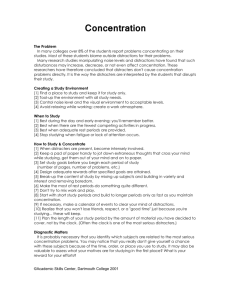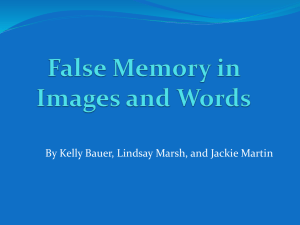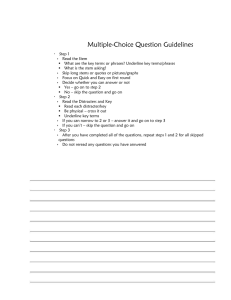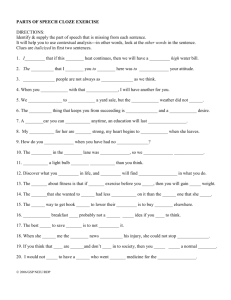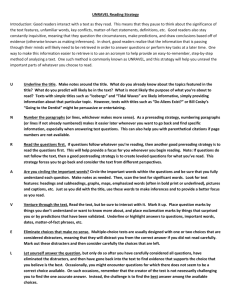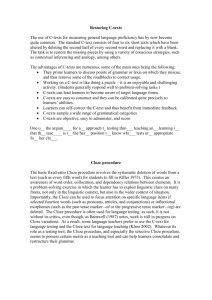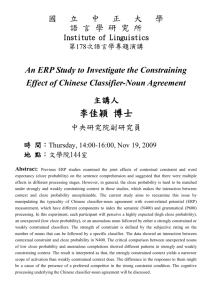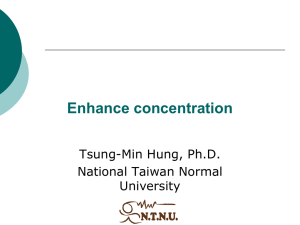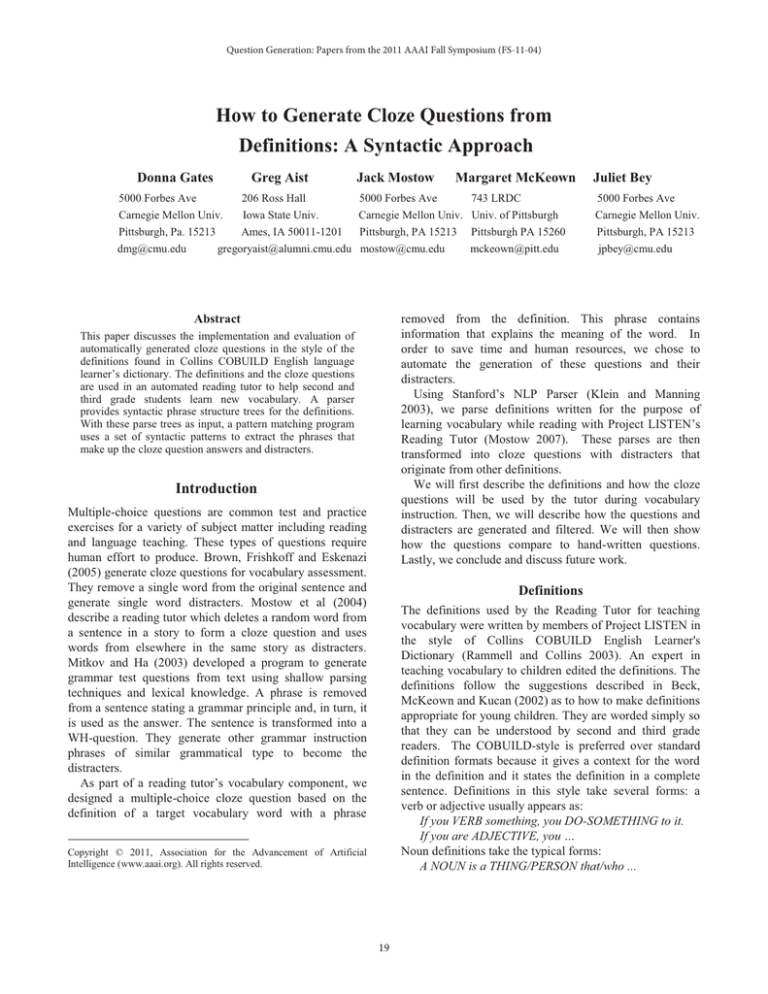
Question Generation: Papers from the 2011 AAAI Fall Symposium (FS-11-04)
How to Generate Cloze Questions from
Definitions: A Syntactic Approach
Donna Gates
Greg Aist
5000 Forbes Ave
206 Ross Hall
Carnegie Mellon Univ.
Iowa State Univ.
Pittsburgh, Pa. 15213
Ames, IA 50011-1201
dmg@cmu.edu
gregoryaist@alumni.cmu.edu
Jack Mostow
Margaret McKeown
5000 Forbes Ave
Carnegie Mellon Univ.
Pittsburgh, PA 15213
mostow@cmu.edu
743 LRDC
Univ. of Pittsburgh
Pittsburgh PA 15260
mckeown@pitt.edu
Juliet Bey
5000 Forbes Ave
Carnegie Mellon Univ.
Pittsburgh, PA 15213
jpbey@cmu.edu
removed from the definition. This phrase contains
information that explains the meaning of the word. In
order to save time and human resources, we chose to
automate the generation of these questions and their
distracters.
Using Stanford’s NLP Parser (Klein and Manning
2003), we parse definitions written for the purpose of
learning vocabulary while reading with Project LISTEN’s
Reading Tutor (Mostow 2007). These parses are then
transformed into cloze questions with distracters that
originate from other definitions.
We will first describe the definitions and how the cloze
questions will be used by the tutor during vocabulary
instruction. Then, we will describe how the questions and
distracters are generated and filtered. We will then show
how the questions compare to hand-written questions.
Lastly, we conclude and discuss future work.
Abstract
This paper discusses the implementation and evaluation of
automatically generated cloze questions in the style of the
definitions found in Collins COBUILD English language
learner’s dictionary. The definitions and the cloze questions
are used in an automated reading tutor to help second and
third grade students learn new vocabulary. A parser
provides syntactic phrase structure trees for the definitions.
With these parse trees as input, a pattern matching program
uses a set of syntactic patterns to extract the phrases that
make up the cloze question answers and distracters.
Introduction
Multiple-choice questions are common test and practice
exercises for a variety of subject matter including reading
and language teaching. These types of questions require
human effort to produce. Brown, Frishkoff and Eskenazi
(2005) generate cloze questions for vocabulary assessment.
They remove a single word from the original sentence and
generate single word distracters. Mostow et al (2004)
describe a reading tutor which deletes a random word from
a sentence in a story to form a cloze question and uses
words from elsewhere in the same story as distracters.
Mitkov and Ha (2003) developed a program to generate
grammar test questions from text using shallow parsing
techniques and lexical knowledge. A phrase is removed
from a sentence stating a grammar principle and, in turn, it
is used as the answer. The sentence is transformed into a
WH-question. They generate other grammar instruction
phrases of similar grammatical type to become the
distracters.
As part of a reading tutor’s vocabulary component, we
designed a multiple-choice cloze question based on the
definition of a target vocabulary word with a phrase
Definitions
The definitions used by the Reading Tutor for teaching
vocabulary were written by members of Project LISTEN in
the style of Collins COBUILD English Learner's
Dictionary (Rammell and Collins 2003). An expert in
teaching vocabulary to children edited the definitions. The
definitions follow the suggestions described in Beck,
McKeown and Kucan (2002) as to how to make definitions
appropriate for young children. They are worded simply so
that they can be understood by second and third grade
readers. The COBUILD-style is preferred over standard
definition formats because it gives a context for the word
in the definition and it states the definition in a complete
sentence. Definitions in this style take several forms: a
verb or adjective usually appears as:
If you VERB something, you DO-SOMETHING to it.
If you are ADJECTIVE, you …
Noun definitions take the typical forms:
A NOUN is a THING/PERSON that/who ...
Copyright © 2011, Association for the Advancement of Artificial
Intelligence (www.aaai.org). All rights reserved.
19
A NOUN is a … THING/PERSON.
For example, below is the definition for the verb abandon:
If you abandon something or someone, you leave them
and never go back.
The following is our definition for the noun steak:
A steak is a large flat piece of meat.
We look for specific syntactic patterns that match the
“defining information” (that part that shows the meaning of
the word) in the definition. For example, in the above
definition, the defining information is you leave them and
never go back.
Parts of this phrase will be removed to become the
blank/answer. The verb phrase (VP) "leave them" is a
candidate for the answer-blank because it matched a
pattern looking for a VP in this context.
One of the syntactic patterns looks for a noun phrase
(NP) with the pronoun you immediately followed by a VP.
This VP becomes the answer and gets added to the list of
other phrases stored for distracter generation that match
"simple-VP-after-you" (which excludes the coordinate
structure). The pattern matches on :
(SBAR (S (NP (PRP you)) (VP (VP x)...
where x is the content we are looking for. The final cloze
question is generated by removing the answer phrase and
replacing it with a 5 underscore blank space.
If you abandon something or someone, you _____ and
never go back. (Answer: leave them)
Yet another pattern is used to capture the complete VP
with the coordinate structure "complex-VP-after-you”
which would match the VP leave them and never go back.
There are also patterns that look for and extract noun
phrases, prepositional phrases, relative clauses and
sentential complements, as shown in Table 1.
Definitions in the tutor
Initially, a student sees the definition of a vocabulary word
when he first encounters it in a story. The next day the
student is asked to perform a vocabulary activity to
reinforce learning. Prior to this, the student is reminded of
the definition via a cloze question.
The definition cloze questions refresh the student’s
memory of the definition of the word whether they get the
answer correct or not. Every day for four days the student
receives a new word practice exercise for a vocabulary
word that was introduced while reading a story earlier in
the week. When the student receives the cloze question for
the definition, he is asked to choose the correct answer
from 2 randomly ordered choices: correct answer vs.
distracter. For example,
A steak is _____.
an old broken down car
a large flat piece of meat
The task is not meant to test the student's knowledge but
to serve as a reminder before starting the word practice
activity. Since there are often 3-5 distracters available to
choose from for each question, the tutor uses a new
distracter each time the cloze question is shown and then
recycles the distracters if it runs out.
Question Generation
The cloze question generator was developed and tested
using 308 student definitions. 30 additional word senses
and definitions were set aside for evaluating the generator.
The syntactic patterns that we use to find the blanks in
the definitions as well as the distracters are based solely on
the phrase-structure trees produced when we parsed the
definitions with the Stanford NLP Parser.
Figure 1
shows an example phrase-structure parse for the definition,
If you abandon something or someone, you leave them and
never go back.
Noun Phrase after BE
A pace is a step you take when you
walk.
Sentential Complement
If you persuade someone, you tell them
what to think or do.
Prepositional Phrase
Your profile is the outline of your face
seen from the side.
Relative Clause
Your attitude about something is the
way you think and feel about it.
Reduced Relative Clause
Your profile is the outline of your face
seen from the side.
Table 1 Examples of phrases matched by syntactic patterns
Distracters
We chose to use the phrases from other vocabulary
definitions rather than generate new phrases or extract
them from other texts. The advantages are that the phrases
are already in language that children can easily read
(simple vocabulary and syntax) and there is no chance that
another vocabulary word will appear accidently since the
definitions were carefully worded to exclude other target
vocabulary words. The target vocabulary word only
appears at the beginning of a definition (i.e., in the initial
subordinate IF clause or before a predicate verb such as
BE).
(ROOT (S (SBAR (IN If)
(S (NP (PRP you))
(VP (VBP abandon)
(NP (NN something)
(CC or)
(NN someone)))))
(, ,) (NP (PRP you))
(VP (VP (VBP leave) (NP (PRP them)))
(CC and) (ADVP (RB never))
(VP (VBP go) (ADVP (RB back)))) (. .)))
Figure 1 Parse of Definition for abandon
20
Based on advice from our vocabulary expert, it was
determined that the following requirements were necessary
for a distracter to pass the human review process:
1. Should be of relatively the same syntactic phrase
type as the answer,
2. Should have roughly the same length as the answer
3. Should not be a possible answer
4. Should be grammatical when inserted into the blank
The fourth constraint allows for some loosening of
person and number agreement constraints, according to the
vocabulary expert, since the point is to make sure the child
learns the meaning and not memorize the definition.
If you construct something, you _____.
*build it by putting parts together
say it in a clear, strong way
change it back to the way it was
clean it by rubbing it very hard
behave badly and are not polite
bring it back from the place where it was left
aim it at them or say it only to them
-- caused it (Filtered: length too-short, Filtered: WordNet definition
for distracter’s vocabulary word (attribute) contains
target word (construct)
Figure 2 Example of semantic filter being overshadowed by
length restriction filter
Distracter Filters
The length of the distracters were filtered so that no
distracter would be more than 20 characters longer or
shorter than the answer with preference for ones that are no
more than 11 characters longer or shorter. These lengths
were determined by hand after repeating the generation
with differing length thresholds and checking with the
vocabulary expert as to which ones appeared to work best
so that the answer and the distracter did not look
significantly different from one another.
The distracters were filtered based on phrase type such
that questions whose answer is a simple VP, only have
distracters that are simple VPs. For example, the answer
for the cloze question If you abandon someone or
something, you _____ and never go back. is the VP leave
them. A good VP distracter would be ask them a question,
or buy them a present but not a large flat piece of meat.
Phrases that matched on exactly the same pattern were
collected and saved to be used as distracters for definitions
with the same pattern.
In an effort to improve the filtering of distracters that are
too closely related semantically to the answer, we tried to
use WordNet (Fellbaum 1998) similar to Gates (2008) to
compare the definitions of the answer word to that of the
source word from which a specific distracter originated.
While there appeared to be evidence that the distracters
could be filtered to with lexical information, an early
evaluation showed that, except in one case, there was no
change to the final 5 distracters selected for each question
when compared to not using any WordNet information.
The syntactic pattern and length filters prevented these
distracters from ever being considered in the first place.
Figure 2 shows the output for the question and distracter
generator displaying the filter warning messages which
state that the distracter cause it is not only too short but
also possibly too close in meaning to the answer to be a
valid distracter.
The filters applied in a specific order: phrase type,
length, and then semantic filter.
To ensure that we generate enough good distracters so
that there is at least one remaining after a human reviews
them, the program selects 5 phrases from the pool of
possible phrases.
Human Review
The generated distracters from the cloze questions for the
33 unseen word senses were reviewed by a human to
determine whether they were adequate distracters for a
given cloze definition. According to our vocabulary expert,
each distracter must not be similar in meaning to the
answer, should not stand out as being longer or shorter,
should not sound completely implausible grammatically,
and should not be too vague or too specific so that it could
be interpreted as a possible answer. The following
example illustrates a cloze question and distracters that are
acceptable and unacceptable.
If you abandon something or someone, you _____ and never go
back.
leave them
(answer)
look for it
(ok: clearly conflicts in this definition)
do it
(too vague: could fit)
are very mean (too close/specific: could fit if you think
it is mean to abandon something)
lose it
(too close in meaning)
look for someone that you have not met before (too long)
Evaluation
The program was evaluated on 33 vocabulary word sense
definitions that were excluded from being used during the
development of the program, the filters and the patterns. A
human, expert in writing cloze questions for children,
wrote 33 cloze questions (sentences with a blank plus an
answer) and another human, expert in writing distracters,
wrote a single distracter for each of the cloze questions. It
took 31 minutes to write 33 cloze questions and 22 minutes
21
to write 33 distracters by hand. In contrast, the question
generator produced 91 cloze questions for the 33 word
senses and over 522 distracters in less than 5 seconds (not
including time to parse the definitions). The two human
experts judged the generated questions and distracters,
taking an average of 49.5 minutes (range 32-67) to review
and note whether the questions and the distracters were
acceptable. For the purposes of this discussion, an item
refers to either a cloze question (definition with blank
space) or to a distracter. Based on items that the judges
agreed on, 73% of the generated output was acceptable.
There were 613 items (91 cloze questions + 522
distracters). This judging process revealed that the
generator produced 356 good items (77 cloze questions +
279 distracters) and 135 bad items (1 cloze question + 134
distracters). The judges were not in agreement on the
remaining 122 items.
In the case of the single unacceptable cloze question, the
answer phrase that was chosen for deletion was simply too
short: If you make a distinction between 2 things, you
_____ or say how they are different. Answer: show
Judging the generated output yielded 7.19 acceptable
items/minute while hand-writing the examples yielded 1.29
items/minute. Since it takes less time per item to judge the
output than write one, a further advantage of generating the
cloze questions automatically is that we get a variety of
questions (2.8 per definition) in approximately 10 seconds
(7 seconds to generate cloze questions and organize phrase
and 3 seconds to group and filter distracters for a specific
cloze question). The current tutor happens to only take
advantage of the extra distracters.
Parsing and pattern matching errors accounted for fewer
than 10 unacceptable cloze questions in the development
set, and no parsing errors occurred in the evaluation set.
Some of the definitions only had 1 or 2 distracters which
were not acceptable. Distracter generation requires a large
enough pool of syntactically similar phrases from other
definitions and, for these cases, there were not enough.
vocabulary and includes 300 automatically generated
definition cloze questions. The experiment is still in the
initial stages at the time of this writing. We hope to have
some feedback from the experiment soon. We would also
like to continue experimenting with a filter to better restrict
the distracters and lessen the cost of human reviewing. If
the generated results can be improved and automatically
thinned out by filters, it would greatly benefit the next step
when we scale up the vocabulary tutor.
Acknowledgements
Presentation of this work was supported by the Institute of
Education Sciences, U.S. Department of Education,
through Grant R305A080157 to Carnegie Mellon
University. The opinions expressed are those of the
authors and do not necessarily represent the views of the
Institute or the U.S. Department of Education.
The authors wish to thank members of Project Listen for
their assistance in preparing the evaluation results and the
anonymous reviewers for their helpful suggestions and
comments.
References
Beck, I. L., McKeown, M. G., and Kucan, L. 2002. Bringing
words to life : robust vocabulary instruction. New York: Guilford
Press.
Brown, J., Frishkoff, G., and Eskenazi, M. 2005. Automatic
question generation for vocabulary assessment. Paper presented
at the HLT/EMNLP conference, Vancouver, B.C.
Fellbaum, C. (Ed.) 1998. WordNet: An Electronic Lexical
Database. Cambridge, Ma: MIT Press
Gates, D. 2008. Generating Look-Back Strategy Questions from
Expository Texts. In Proceedings of the Workshop on the
Question Generation Shared Task and Evaluation Challenge,
NSF, Arlington, VA.
Klein, D., and Manning, C. 2003. Fast Exact Inference with a
Factored Model for Natural Language Parsing. Advances in
Neural Information Processing Systems 15 (NIPS 2002), 3-10.
Mitkov, R., and Ha, L. A. 2003. Computer-aided generation of
multiple-choice tests. Paper presented at the HLT-NAACL 2003
Workshop on Building Educational Applications Using Natural
Language Processing, Edmonton, Canada.
Mostow, J., Beck, J., Bey, J., Cuneo, A., Sison, J., Tobin, B., and
Valeri, J. 2004. Using automated questions to assess reading
comprehension, vocabulary, and effects of tutorial interventions.
Technology, Instruction, Cognition and Learning, 2, 97-134.
Mostow, J., and Beck, J. 2007. When the Rubber Meets the Road:
Lessons from the In-School Adventures of an Automated Reading
Tutor that Listens. Scale-Up in Education, 2, 183-200.
Rammell, C. and Collins. (Eds.) 2003. Collins COBUILD
Learner's Dictionary. HarperCollins.
Discussion
While over-all it took less time to write a cloze question
and a single distracter by hand, it was more efficient to
have a human review generated items on a per item basis.
A further advantage of automatically generating the cloze
questions is that it produced a variety of questions in
different forms that could be used by the tutor on different
days. The current tutor happens to only take advantage of
the extra distracters.
Future Work
The Reading Tutor is currently being used in an
experiment with second and third graders learning
22

